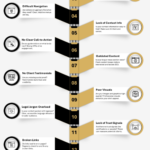If you’re struggling to generate new clients from your website despite spending a king’s ransom on design, it’s time to reevaluate your law firm’s landing page.
Remember the good old days when you could simply depend on word-of-mouth referrals to bolster your law practice? In a recent study surveying 1,578 participants, 15.5 percent reported that they relied on the internet to search for an attorney.
Today’s consumer varies significantly from those a decade ago or even five years ago. They are more tech-savvy and less patient. So, to capture their attention, every word on your website must have an impact, or you risk pushing your audience into the arms of your competition. This is where your lawyer landing page comes in.
Generate More Leads with Multiple Landing Pages for Your Law Firm
A landing page is a web page where internet users arrive after clicking a link from an email, online advertisement, search result, social media post, or other digital location. Many law firms make the mistake of focusing all their marketing efforts on their homepage. But while your homepage is what sets the stage for your audience to learn more about your firm and become intrigued with your brand, your landing page is what will ultimately get you the standing ovation or a new lead for your firm. In other words, the sole purpose of your landing page is to entice site visitors to take a specific action — and the more, the better. According to HubSpot, businesses with 10 to 15 landing pages received more than a 50 percent increase in leads.
Set a Goal for Your Law Firm’s Landing Page
Creating a landing page with no goal is like going for a cross-country road trip with no map. Without an objective, you risk investing unnecessary time and energy, not to mention marketing dollars, into creating a landing page that produces less-than-stellar returns. Your goal should incorporate the following factors: the action you want your audience to take, the format you will use to accomplish this result, and the number of leads that would deem your online marketing campaign successful.
The three common types of lawyer landing pages are lead generation, opt-in, and webinar signup. The intent behind a lead generation landing page is to capture your audience’s contact information. This type of page typically includes a short form where visitors can fill out their name, email, and phone number. An opt-in landing page, on the other hand, offers something of value in exchange for their email address. Once internet users submit their email, they would then receive a link to download a free guide, ebook, or some other form of valuable content.
Webinar signup landing pages are just as the name implies, a page where visitors sign up for access to a webinar in exchange for their contact details.
Once you’ve identified the desired outcome for your landing page, set benchmarks to gauge its success, such as the number of leads received or the number of visitors converted into clients.
Focus on Customer-Centric Copywriting for Your Law Firm’s Landing Pages
Strong copy for your landing page is crucial. It can be the difference between landing a new client or a new client landing on your competitors’ site. Many law firms attempt to write their copy themselves but fail to encompass the elements critical for favorable search engine rankings and conversions. Hiring a skilled copywriter can help alleviate the headache of determining which keywords go where and how to frame your message to inspire action.
For your landing page to convert, it must contain a few key factors: a powerful headline, a value proposition that addresses your audience’s pain points, a clear call to action, and social proof or testimonials. Follow the landing page best practices below to maximize your lead-generating power.
-
Write a benefit-focused headline.
Your headline is the first thing your audience will see upon arriving on your landing page. While eight out of 10 people will read your headline, only two will read the rest of your content. With this in mind, approach your headline with the perspective of how your potential client will benefit. Think about the challenges they are facing and how your service will provide a solution. Your headline should be no more than eight words to keep your message clear and concise.
-
Communicate Your Value in Your Client’s Words.
This section of your page will elaborate on your headline, telling potential clients what your law firm can offer them and, more importantly, what sets your firm apart from others. To achieve this, consider your client’s needs and then tie them back to your law firm’s expertise and experience.
-
Get Clear on Your Call to Action.
Regardless of how strong your copy is, your landing page will fall flat if you neglect to include a compelling call-to-action (CTA). Your CTA should specifically spell out what you want visitors to do, using action verbs like “Learn More” or “Schedule a Free Consultation.” To ensure readers know what to do once they arrive on your landing page, feature your CTA above the fold or towards the upper portion of your page.
-
Drive Your Offer Home with Social Proof.
In today’s information-obsessed world, potential clients view online reviews in the same regard as personal recommendations from family and friends. Eighty-two percent of people stated that positive reviews influence whether they use a business’ services. According to a Local Landing Page Study, thirty-seven percent of the top landing pages feature testimonials. Adding reviews to your landing page helps you build trust with your audience, making them more apt to do business with you.
Conclusion
Technological advances and the coronavirus pandemic have undeniably altered the way law firms do business. However, along with change come vast opportunities to level the playing field for firms that don’t have a supersized budget. With the proper implementation, landing pages can not only help you strengthen your online presence but also increase conversions. Follow the tips above to transform your website into a 24-hour lead-generating machine.
For additional guidance on landing pages, please feel free to utilize the resources below.
https://bloggingwizard.com/landing-page-statistics/
https://www.clio.com/blog/should-lawyers-use-landing-pages/
https://www.martindale-avvo.com/blog/local-search-weapon-part1/
https://www.martindale-avvo.com/blog/local-search-weapon-part2/






One thought on “Why Not Having a Law Firm Landing Page is Costing You Clients”
Pingback: 7 Website Copywriting Tips Personal Injury Lawyers Don't Realize They Need - Legal Copywriting Central